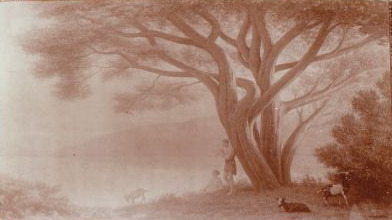Daphnis and Chloe
Achilles Bentos' predilection for themes from ancient mythology is well known (see, among others, the paintings of Leda and the swan). Another theme that Bentos took up at least twice is that of Daphnis and Chloe.
The story of these two young people is known to us from a novel written by a certain Longus, a Greek author of the 2nd or 3rd century AD about whom very little is known.
Daphnis and Chloe are both abandoned children on the island of Lesbos; they are nursed, one by a goat, the other by a sheep. He becomes a goatherd, she a shepherdess. Then, when Daphnis and Chloe are 15 and 13, the god Eros makes them fall madly in love with each other. But they are both young, awkward, and rather ignorant of the things of love. Their adventures, however, end in marriage.
The theme of love-struck persons who spend entire days naked, not knowing how to act, is a theme that has been taken up by a number of artists, at least since the Renaissance. Just look at the Pinterest page dedicated to our two young shepherds.
Visual art, poetry and even music have chosen this loving couple as a theme.
A long poem by Andrew Marvell (1621-1678) is dedicated to this young couple. We will only cite the first three strophes.
i
Daphnis must from Chloe part:
Now is come the dismal Hour
That must all his Hopes devour,
All his Labour, all his Art.
ii
Nature, her own Sexes foe,
Long had taught her to be coy:
But she neither knew t' enjoy,
Nor yet let her Lover go.
iii
But, with this sad News surpriz'd,
Soon she let that Niceness fall;
And would gladly yield to all,
So it had his stay compriz'd.
The French painter François Boucher produced the magnificent painting of Daphnis and Chloe (1743, The Wallace Collection, London) and Marc Chagall realized 42 magnificent lithographs (1961) to illustrate the antique novel by Longus.
Jacques Offenbach composed an operetta dedicated to this theme (1860). And we cannot forget to mention Maurice Ravel's work which was created by Serge Diaghilev and his
Ballets Russes in 1912.

So we know at least several paintings by Achilles Bentos. The first one is well known to us; it shows Daphnis is playing the flute in a pine forest, while Chloe, at her side, looks melancholically towards the sea. Bentos entitled it Daphnis and Cloe and a note states that he reproduced a landscape in the vicinity of Cannes.


Another version is
intriguing. We only know it from an old sepia photograph. Bentos entitled it
Daphnis & Cloé. Daphnis is standing and playing the flute while Chloe is
sitting and seems to be daydreaming. A few goats adorn the scene.
Interestingly, in one of the photographs of Achilles De Maertelaere in his
studio, a very similar painting is hanging on the wall. However, the foreground
is somewhat different: the grove in the lower left-hand corner is not present on the
sepia photograph and the goats are placed differently. Is this another work or
a final retouch? It is difficult to say, but as we know that the artist
sometimes reuses a composition to make another painting, the first hypothesis
seems more credible

The last version seems to be based on the same theme and is known, for the moment, only from a sepia photograph; Achilles Bentos entitled it "The Morning". A flute player at the foot of a tree could also be Daphnis. Here too, it was the Cannes region that inspired the painter.
In any case, this theme, which was much appreciated by Achilles Bentos, produced magnificent examples showing all the painter's art and his qualities in representing landscapes.
Translated with www.DeepL.com/Translator
